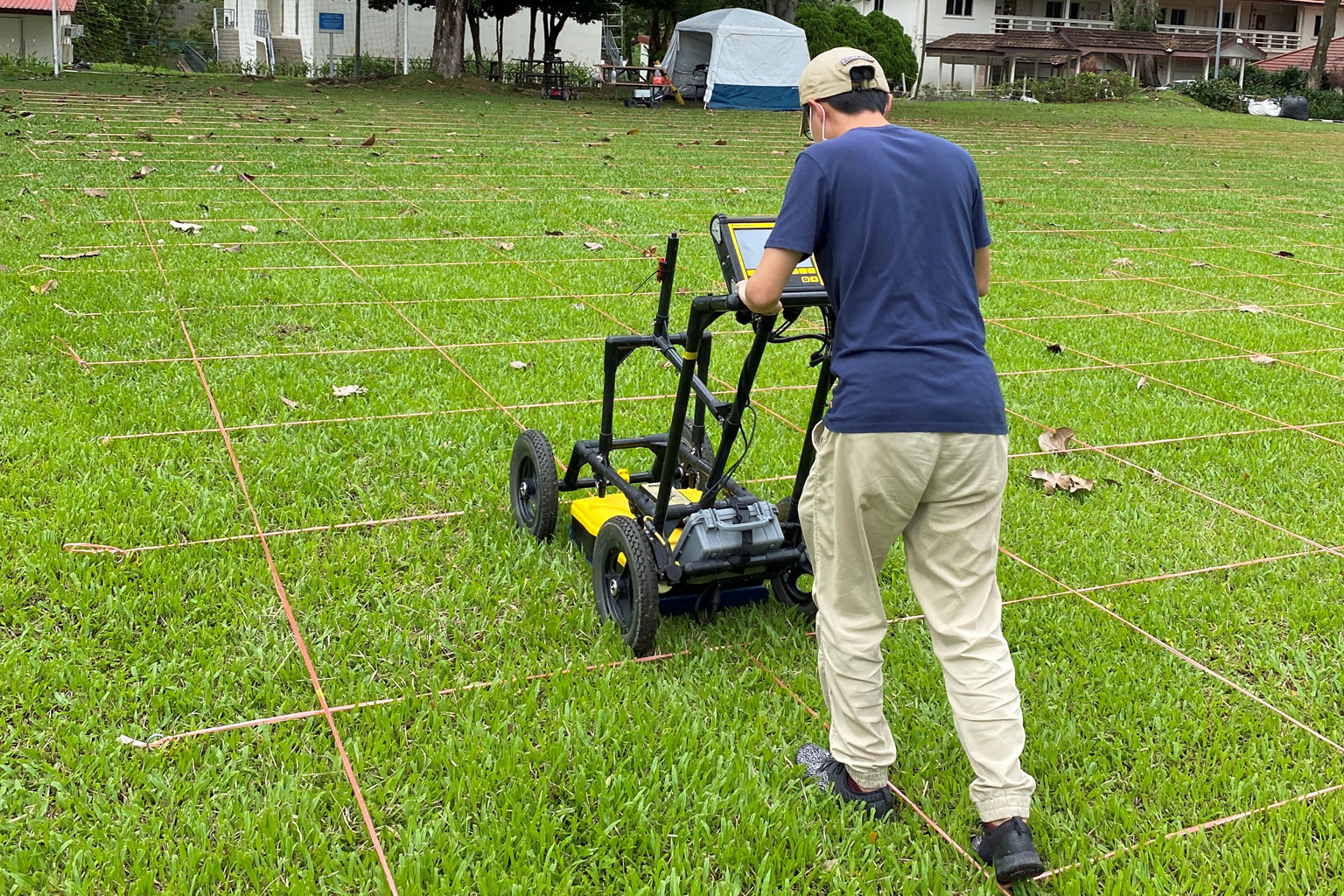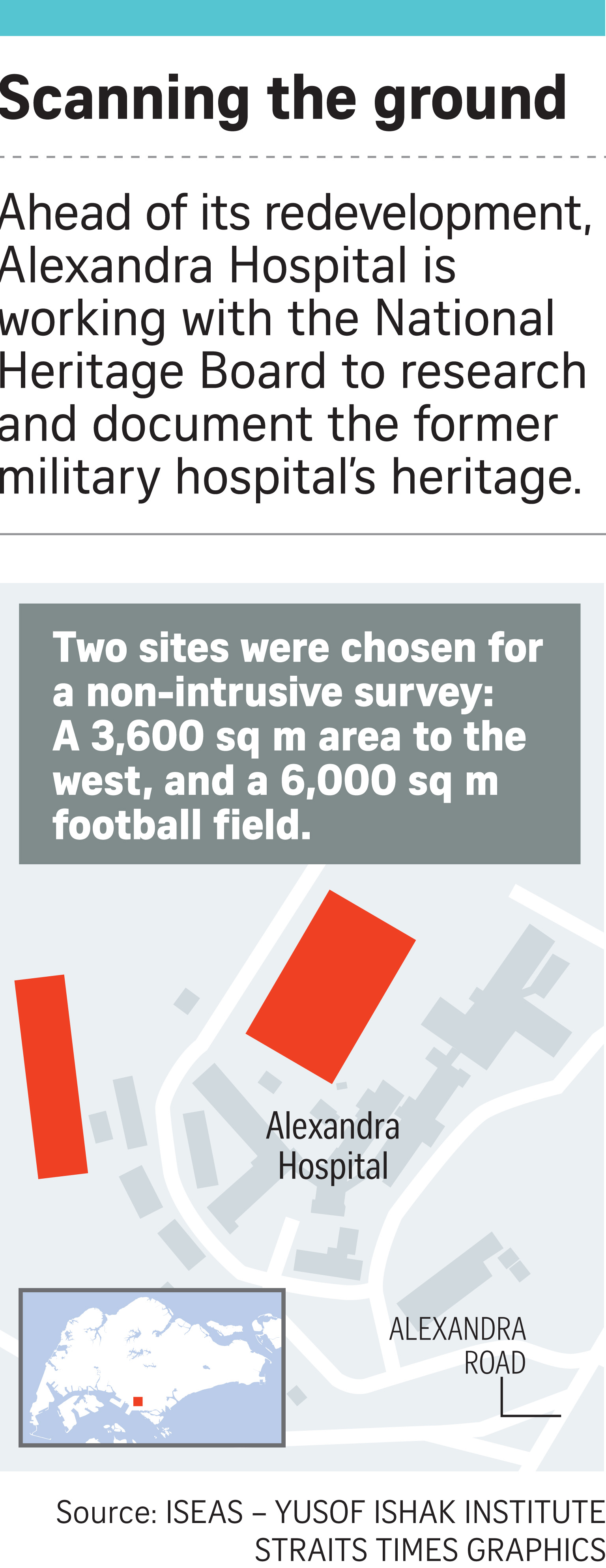Archaeological survey being conducted at Alexandra Hospital
Sign up now: Get ST's newsletters delivered to your inbox

A ground-penetrating radar device being used at a football field at Alexandra Hospital as part of the survey. The 6,000 sq m field is believed to be the site of a mass grave of victims who died during World War II.
PHOTO: ISEAS - YUSOF ISHAK INSTITUTE
Follow topic:
In one account of the Alexandra Hospital massacre of Feb 14, 1942, its football field was where Japanese soldiers gathered wounded soldiers and staff, tied them by the hands in groups, and led them away to a small building at the back of the hospital grounds.
The field of about 6,000 sq m is also believed to be the site of a mass grave of the victims.
An estimated 200 people - including patients - died over two days at the hands of the Japanese.
The site's significance is not lost on the hospital's current management and the National Heritage Board (NHB).
The two organisations are working together to survey the field, and a 3,600 sq m area at the western end of the compound, ahead of the hospital's redevelopment, which will see its grounds expanded towards Queensway.
The hospital will be redeveloped into an integrated health campus by 2030, as previously announced.
Without mentioning World War II, spokesmen for Alexandra Hospital and NHB told The Straits Times they are conducting research and documenting the site's heritage "in view of the historical significance of the hospital compound".
For now, the archaeological survey involves non-intrusive scanning of the ground.
An NHB spokesman said the survey fieldwork - which began in December - has been completed, and "all findings are being analysed to determine if there is a need to conduct further investigations".
"Any materials found during the investigation will be assessed by the archaeological surveyors and NHB, and may undergo further reviews, as necessary," the spokesmen added.

An archaeology team from the ISEAS - Yusof Ishak Institute was commissioned by NHB to conduct the survey.
Asked why the two specific sites were chosen for the survey, the NHB spokesman said: "They have relatively uniform terrain and over-ground obstructions are absent, and are therefore suitable for ground-penetrating radar (GPR) surveying.
"Geophysical methods such as GPR are commonly used by archaeologists as a non-intrusive way to survey landscapes, which can provide extensive ground imaging without disturbing the ground."
Procurement documents published last October show that the survey is seeking to "locate and determine the extent and the nature of any anomalous subsoil feature(s) such as backfill, old building foundation and walls, soil cavities and services" that may be attributed to the early and mid-1900s.
Such features are expected to be within the first one or two metres below the surface.
The documents also have provisions for a contractor to provide equipment and manpower needed for trial trenching, if it is deemed necessary after the GPR results are assessed.
Trial trenching is a quick method that allows archaeologists to determine the archaeological value of a site, where several trenches are dug for evaluation, leaving the majority of the site untouched.
A single explanation for the massacre has not been found, but some claim the Japanese were pursuing troops that had fired at them from the hospital grounds.
About 50 victims were shot or bayoneted in the wards during the rampage, including one patient undergoing surgery on the operating table, while about 150 people who were rounded up and kept in three small rooms overnight either died there or suffered the same fate as those in the wards over the course of the night and the next morning.
Dr Jack Lee, president of the Singapore Heritage Society, welcomed the news of the archaeological survey, saying that studies of sites being redeveloped, especially in locations where there is a chance of artefacts being found, should be encouraged.
He added that while the present archaeological investigation is taking place on state-owned land, he hoped that private land owners will also allow researchers to have the time to carry out similar research in the future "so that the chance to learn more about Singapore's heritage is not lost in the constant redevelopment of the urban landscape".
Heritage author Jerome Lim said that while it is difficult to predict what this survey might uncover, it is important to carry it out before redevelopment, which may prevent anything of historical significance from ever being discovered.
He hoped that more attention will be paid to the heritage value of other buildings on the hospital's grounds, other than the three blocks that have already been conserved.
"I feel some further consideration should be made for their conservation due to the history of the site as Britain's main military hospital in Singapore from 1940 to 1971," he said.
An NHB spokesman said the survey fieldwork - which began in December - has been completed, and "all findings are being analysed to determine if there is a need to conduct further investigations".

